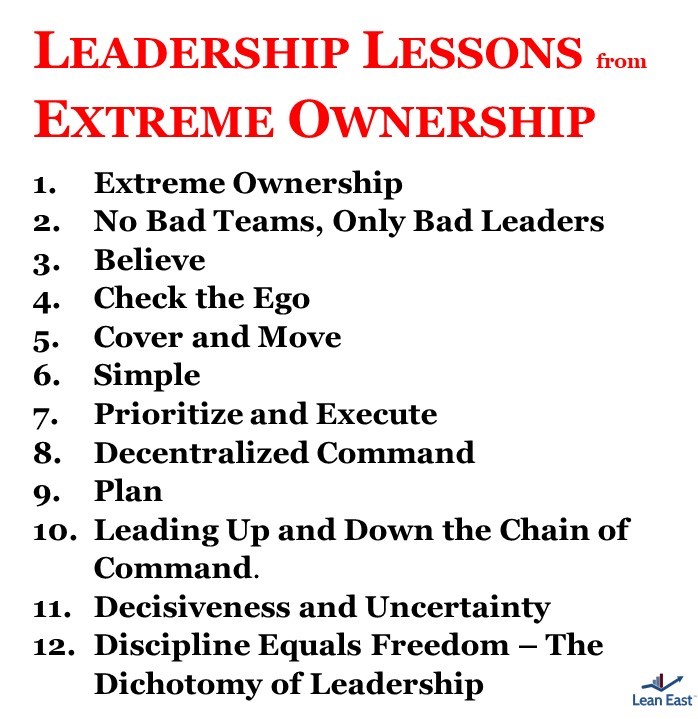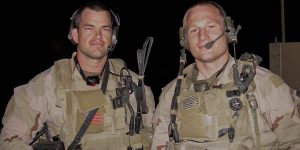 This post shares the lessons from the 2015 book Extreme Ownership: How US Navy SEALs Lead and Win by Jocko Willink and Leif Babin. Willink and Babin were Navy SEALs who led the most highly decorated special operations unit of the Iraq war. The book demonstrates how SEAL leadership principles and the concept of “extreme ownership” apply to business.
This post shares the lessons from the 2015 book Extreme Ownership: How US Navy SEALs Lead and Win by Jocko Willink and Leif Babin. Willink and Babin were Navy SEALs who led the most highly decorated special operations unit of the Iraq war. The book demonstrates how SEAL leadership principles and the concept of “extreme ownership” apply to business.
Each chapter describes a situation from the war in Iraq in the insurgent occupied Ramadi where Babin led a unit that reported to Willink. Stories from the battlefield demonstrate each principle, then the authors define the principle and share an example from a business situation that further demonstrates the principle. Many of the principles are well covered in other leadership books, but several are lesser-known.
This post will describe the leadership principles themselves. If you enjoy reading about risky combat missions, Willink and Babin have some engaging stories that make the principles more memorable.
-
Extreme Ownership.
Responsibility for team success and failure rests with the leader. Great leaders acknowledge mistakes and admit failures. They must be loyal to the mission and team over any individual.
As a leader, always begin by focusing on what you are going to do differently, not what other people need to do. Always accept blame foisted on your team but pass on any praise to the members of the group.
The authors feel this principle is the number one characteristic of any high-performing team.
-
No Bad Teams, Only Bad Leaders.
The book shares a story from SEAL basic training where a leading team and an underperforming team became equals simply by switching leaders. This principle takes the concept of extreme ownership to a higher level and attempts to remove any excuses for a leader not accepting full responsibility for his/her team.
-
Believe.
Leaders must understand the mission (vision, goal or greater cause) of the team or organization. Leaders can only pass on their understanding and belief in the goal to the frontline troops when they believe it first. If the frontline believes why, they can move forward, fully believing what they are doing. A team will notice when the leader’s belief waivers.
If you, the leader, don’t understand the why of your team’s mission it is your responsibility to ask.
-
Check the Ego.
Implementing Extreme Ownership requires checking your ego and operating with a high degree of humility. Be confident, but not cocky. Never get complacent, and don’t forget that your competition is capable and eager to exploit your weaknesses.
-
Cover and Move.
This principle refers to how SEAL units advance in a mission – half the troops provide cover fire while the rest of the team presses forward and then they exchange roles. Teamwork is critical and each member of the team must do their part or else the entire group is compromised. Work together, communicate with each other, and mutually support one another.
-
Simple.
Both work and combat have inherent complexities. Simplify your mission, plans, and goals as much as possible so people on the team can easily understand them. If your team doesn’t “get it” then you have not kept things simple and you have failed.

-
Prioritize and Execute.
A leader must remain calm and make the best decisions possible. SEALs verbalize this principle with the direction: “Relax, look around, make a call.”
Even the most competent leader can become overwhelmed if they try to tackle too many priorities at the same time. Instead, determine the highest priority task and execute it.
-
Decentralized Command.
Human beings are generally not capable of managing more than 6 to 10 people effectively. Teams must be broken down into manageable elements of 4 to 5 operators with a clearly designated leader. Ensure clarity in the organizational structure so that all teams know their leader and who they can talk to about mission and goal questions.
Leaders at all levels must know the mission so they can make quick decisions when there is no time to obtain an okay from those above. Read our post about operating in a Team of Teams structure for more on this key principle.
-
Plan.
Good plans have the following characteristics:
-
- Leaders must identify clear directives for the team, including the desired “end-state” of the operation.
- The deeper purpose and strategic vision of the goal should be explained.
- Different courses of action must be explored on how to accomplish the goal.
- Leaders must delegate planning as far down the chain as possible so there is ownership at all levels of the organization. Senior leaders shouldn’t get bogged down in the details.
- Detailed plans should be briefed to the entire team, with senior leaders identifying any weaknesses or holes in the plan.
- Contingencies should be planned and key risks mitigated.
The test for a successful brief is: “Do the team and the supporting elements understand it?”
-
Leading Up and Down the Chain of Command.
It is paramount that senior leaders explain to their junior leaders and troops or employees executing the mission how their role contributes to the big picture success. This understanding helps the team members prioritize their day-to-day efforts in the complex business environment.
Key factors are to:
- Take responsibility for leading everyone, subordinates and superiors alike.
- If someone isn’t doing what you need them to do, determine what you can do to better enable this.
- Don’t ask your leader what you should do, tell them what you are going to do.
-
Decisiveness and Uncertainty.
Uncertainty, chaos, and the element of the unknown make leading challenging. There is no 100% right solution, and the picture is never complete. Leaders must understand this, be able to make decisions promptly, and adjust those decisions based on new information.
-
Discipline Equals Freedom – The Dichotomy of Leadership.
Every leader walks a fine line and must be:
- Confident but not cocky
- Courageous but not fool-hardy
- Competitive but a gracious loser
- Attentive to details but not obsessed by them
- A leader and a follower
- Strong but have endurance
- Humble not passive
- Aggressive but not overbearing
- Quiet not silent
- Logical but not robotic
- Close to the team but not too close to one member or so close that the team forgets who is in charge
- Able to execute extreme ownership while exercising decentralized command
When a leader struggles, it is likely because they have leaned too far in one direction and disrupted this balance.

Application:
While there is nothing new in Extreme Ownership, the principles are great to review and consider. How many of the principles do you follow as a leader? What do you consider your improvement areas? Where are your blind spots – the areas your team members would suggest you improve?
Please connect with Lean East if you need help developing your leadership skills and ask about our new leadership program beginning in the spring of 2020. Comments below will work!





Thank you. Very helpful summary
This was a sharp read — love how you break down applying SEAL principles to everyday leadership. Extreme ownership training isn’t just theory, it’s a mindset shift that transforms results. Curious for more? Check this out: events.echelonfront.com/